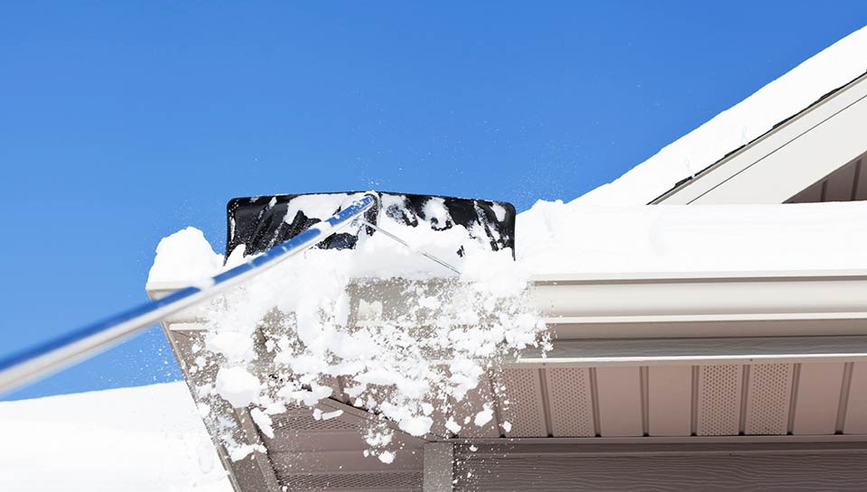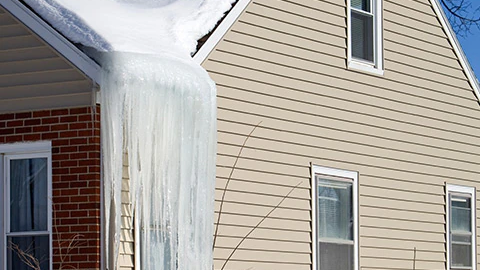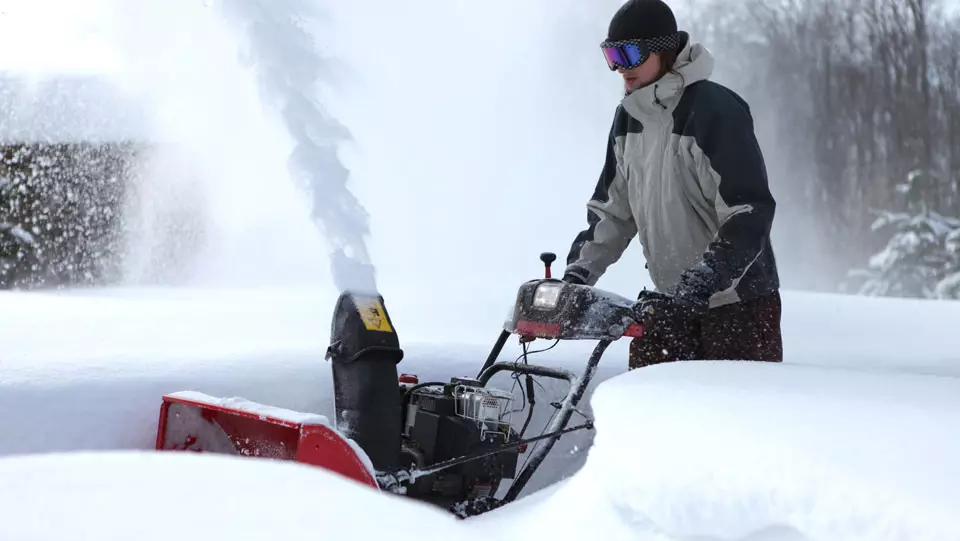Tips to Safely Remove Snow from Your Roof


While snow-covered roofs can make for a picturesque winter scene, the combination of freshly fallen snow with the melting and refreezing of snow can place stress on the roof of your home or business.
Snow removal tips
The amount of snow and ice your roof can support will depend on a number of factors, including the roof type and the age and condition of the structure. But a good rule to keep in mind is if more than a foot of heavy, wet snow and ice has accumulated on your roof, you should have it removed.
Clearing the snow off your roof from the gutters or eaves upward of three to four feet after each winter storm can help prevent ice dams from forming. Remember to avoid using a ladder in snowy and icy conditions. This can be extremely dangerous and is best left to professionals.
For flat roofs
If your flat roof is easily accessible from an interior stairway, you may want to shovel the roof, but be careful not to damage the roof covering. Make sure you can safely access the roof and stay a safe distance from the edge while you work. Better yet, consider hiring a professional to clear the roof.
For sloped roofs
It may be possible to remove the snow and ice from your sloped roof using a roof rake – a long-handled tool designed specifically for this purpose. Stand on the ground and pull as much of the snow off the eaves as you can safely reach.
12 do-it-yourself home snow removal tips
If you decide to handle roof snow removal on your own, here are some helpful tips and best practices to help you to remove snow and ice as safely and effectively as possible.
1. Work with a partner
Snow removal is a hazardous task. It’s smart to partner with someone else when removing snow from your roof. They can be on the lookout for your safety and get help in an emergency.
2. Plan and prepare for winter weather
It’s common for people to experience hypothermia, frostbite and cardiac arrest while doing heavy lifting in freezing weather.1 Take precautions and dress warmly in layers and wear a hat, gloves and work boots before taking on winter roof snow clearing.
Tip: It’s a good idea to monitor weather forecasts when trying to figure out when to remove snow from your roof. Winter weather patterns often create storm clusters. You’ll want to make clearing your roof a priority if there’s a likelihood that a new storm could pile on more snow, making the situation riskier.
Put simply, if you have the option of removing five inches of snow instead of waiting to clear 12 inches, you should do so. As additional layers accumulate, you could end up with ice forming under snow layers, which makes removal even more dangerous.
3. Monitor the condition of your roof and its support structure
Many homeowners only think about their roofs every 20 or 30 years, when wear makes it obvious it’s time for a replacement. It’s actually a smart idea to check your roof and its support structure regularly, looking for wear, dips and other signs of weakness. Pay special attention to vulnerable areas around vents, valleys, hip joints, skylights, gables, gutters, rakes and peaks. If something does not seem quite right, have it checked by a roofing professional. A bit of prevention now can help you to avoid some serious issues in the future.
4. Invest in a roof rake
Even roofs with a healthy slope can accumulate snow and ice. This added weight and water puts a strain on your roof. A roof rake lets you stay on the ground and pull the snow down. They’re typically designed with a telescoping handle to give you longer reach. You can purchase one from a hardware or home improvement store or buy one online.
5. Stay on the ground as much as possible and be mindful of your positioning
When shoveling snow, you’ll want to stay on the ground as much as possible. Climbing on top of a roof or a ladder to brush away snow can result in dangerous slips and falls from a high height. To stay safe, stand on the ground and use a tool such as a roof rake to pull the snow down. To avoid pulling heavy, wet snow drifts on top of yourself, stand to the side of the roof on the ground while using the appropriate tools. Stay alert for falling icicles, too.
6. Don’t go up on your pitched roof to remove snow
In most cases, you can clear enough snow from ground level with a roof rake. It’s much safer to use a roof rake from the ground than from a ladder. If you must use a ladder, make certain it’s solidly secured and have someone hold it and assist you so it doesn’t slide. Always be on the lookout for ice building up on the rungs of the ladder. You may significantly reduce your risk of injury if you never set foot on your roof, especially if it’s a pitched one.
Tip: You can make rooftop snow removal easier by applying de-icer along the eaves.
7. Don’t take off all the snow from your roof
It’s not necessary to remove all the snow from your roof. In fact, trying to scrape it all off could cause damage2 to the roof covering, resulting in potential leaks or structural damage to your roof. With this in mind, leave at least an inch or two of snow left when you’re done cleaning your roof.
8. Avoid sharp tools and harsh chemicals
Ice picks, mechanical equipment and other sharp objects should never be used for rooftop snow clearing. They could also conduct electricity if they come in contact with a power line. Likewise, don’t use harsh chemicals to remove snow. The risk of damage is high and could result in leaks or more serious issues.
9. Don’t forget the gutters and downspouts
Make sure to keep gutters and drains clear and free of ice and snow. Icicles can be a sign that gutters are blocked and unable to function correctly. Also, make sure downspouts and extensions are free of snow and obstructions at ground level so water can flow through and not back up.
10. Watch for falling snow and icicles
Hanging icicles can be pretty, but they can also be dangerous. Buildup of ice, or ice dams, prevents gutters from working correctly and can push back into your roof, causing future problems. They can also snap off and cause damage or injury.
11. Never manually apply heat to remove snow
Don’t use electric heating tools such as heat guns or hair dryers to remove snow and ice. Open flame devices such as torches should also be avoided.3 These can result in flooding or cause the snow to collapse quickly and create a dangerous avalanche-like situation. Heating devices can also cause fires.
12. Work in small batches and work safely
It’s usually best to remove heavy drifts of snow first to eliminate the biggest risks for roof collapse. Don't create a pile of snow on the roof and then pull it all down at once. Pull small amounts toward you at a time. Work from the area closest to you and then move upward.
Start taking off snow from the edge and then work your way into the roof. However, if you have a gabled roof, start at the ridge and work toward the eaves.
It’s always a good idea to step back and think about the best way to approach snow clearing before beginning the work. Every storm is different and leaves different amounts and drifts of snow behind. A little forethought can help prevent damage and avoid safety risks.
Get professional help to remove snow from your roof
Snow removal can be a difficult and dangerous undertaking. Consider leaving the task to professionals. Contact a homebuilder, landscaping and roofing contractor, or property maintenance company to remove the snow and ice.
Start scouting reputable companies in the fall to enlist their aid so you’re not scrambling to hire one at the last minute when they may be steadily booked. Before hiring a contractor, check their references. Always make sure any contractor you hire is qualified, insured and bonded.
Review your homeowners insurance coverage
The change of seasons is a good time to consult with your local independent agent or Travelers representative to review your coverage. Think ahead to make sure you have the right coverage to help protect against weather-related risks to your home and property.
Sources
1 https://www.health.harvard.edu/blog/can-shoveling-snow-put-your-heart-at-risk-2017120612887
2 https://www.fema.gov/sites/default/files/2020-07/fema_snow_load_2014.pdf
3 https://snow.dc.gov/page/snow-safety-tips



